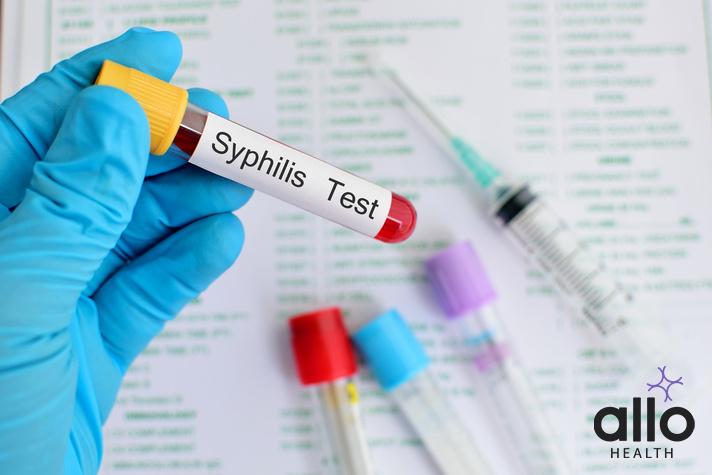Treating Ocular Syphilis: Understanding the Treatment Options

Allo Health is dedicated to personalized well-being, offering support and trusted information tailored to individual health goals. The platform emphasizes human-generated content, led by a distinguished medical team of experts, including physicians and sexual health specialists. Their commitment to credibility involves rigorous fact-checking, authoritative research, and continuous updates to ensure accurate, up-to-date information. Allo Health's unique approach goes beyond conventional platforms, providing expert-led insights and a continuous commitment to excellence, with user feedback playing a crucial role in shaping the platform's authoritative voice.

Dr. Ajay Ravi holds an MBBS degree from JSS Medical College, Mysore. He has worked closely with the psychiatry department at JSS and has gained experience in the field of Sexual health and medicine.
Why This Was Upated?
Our experts continually monitor the health and wellness space, and we update our articles when new information became available.
Updated on 17 March, 2024
- Article was updated as part of our commitment to diversity, equity, and inclusion.

"The following blog article may discuss medical treatments and interventions. However, it is important to note that the information provided is for general educational purposes only and should not be considered as a substitute for professional medical advice, diagnosis, or treatment. Always seek the guidance of a qualified healthcare professional for personalized medical advice.
Book consultation
Medical treatments are complex and should be tailored to individual circumstances. The information presented in this blog may not be applicable to everyone, as each person's medical condition, history, and needs are unique. Only a qualified healthcare professional can evaluate your specific medical situation, consider relevant factors, and provide appropriate recommendations for diagnosis, treatment options, and monitoring.
It is crucial to note that self-diagnosis, self-medication, or relying solely on the information provided in this blog for treatment decisions can have serious health consequences. "
If you are someone who has been diagnosed with ocular syphilis, then it is important to understand the various treatment options available to you. In this article, we will be discussing everything you need to know about the condition, including its symptoms, causes, diagnosis, and treatment options.
What Is Ocular Syphilis?
Ocular syphilis refers to the manifestation of syphilis, a sexually transmitted infection caused by the bacterium Treponema pallidum, in the eyes. Syphilis typically progresses through several stages, including primary, secondary, latent, and tertiary stages. Ocular syphilis usually occurs during the secondary or tertiary stages of the infection.
- Causes and Transmission:
- Syphilis is primarily a sexually transmitted infection, but it can also be transmitted through blood transfusion or from an infected mother to her baby during pregnancy (congenital syphilis).
- Ocular syphilis occurs when the bacteria invade the eye tissues.
- Symptoms:
- Ocular syphilis can present with various symptoms, including redness, pain, blurred vision, and changes in visual acuity.
- Other symptoms may include eye inflammation, sensitivity to light (photophobia), and floaters (small moving specks or clouds in the field of vision).
- The infection can affect different parts of the eye, including the uvea (uveitis), retina (retinitis), and optic nerve.
- Diagnosis:
- Diagnosing ocular syphilis involves a combination of medical history, clinical examination, and laboratory tests.
- Blood tests, such as the Venereal Disease Research Laboratory (VDRL) or Treponema pallidum particle agglutination (TPPA), are commonly used to confirm the presence of syphilis.
- Treatment:
- Ocular syphilis is treated with antibiotics, primarily penicillin. The specific antibiotic, dosage, and duration of treatment depend on the stage and severity of the infection.
- Individuals allergic to penicillin may be given alternative antibiotics, such as doxycycline or ceftriaxone.
- Follow-Up and Monitoring:
- Regular follow-up is essential to monitor the response to treatment and assess any complications.
- Ophthalmologic evaluations may be required to ensure the resolution of eye symptoms and prevent long-term damage.
- Complications:
- If left untreated, ocular syphilis can lead to severe complications, including permanent vision loss.
- The infection can cause inflammation in various eye structures, affecting the optic nerve, retina, and other components crucial for vision.
It is crucial to seek prompt medical attention if any symptoms suggestive of ocular syphilis are experienced. Early diagnosis and treatment are key to preventing complications and minimizing the impact on vision. Individuals at risk for syphilis should practice safe sex and undergo regular screenings to detect and treat the infection in its early stages.
Ocular Syphilis Causes & Symptoms
Causes of Ocular Syphilis:
Ocular syphilis is caused by the bacterium Treponema pallidum, which is responsible for syphilis. The infection is typically transmitted through sexual contact, but it can also be acquired through other means such as:
- Congenital Transmission: A pregnant woman infected with syphilis can transmit the bacterium to her unborn child. Congenital syphilis can lead to a variety of complications, including ocular syphilis.
- Blood Transfusion: Although rare, syphilis can be transmitted through contaminated blood products during transfusions.
- Direct Contact: Direct contact with syphilis sores (chancres) or mucous membranes of an infected person can result in transmission.
- Unprotected Sexual Activity: Engaging in unprotected sexual activities with an infected person increases the risk of contracting syphilis, which can then lead to ocular involvement.
Symptoms of Ocular Syphilis:
Ocular syphilis can manifest with various symptoms, and these may vary depending on the specific structures of the eye affected. Common symptoms include:
- Redness: Inflammation of the eye structures can cause redness, giving the eyes a bloodshot appearance.
- Pain: Ocular pain may be present, and it can range from mild discomfort to severe pain, depending on the extent of inflammation.
- Blurred Vision: Changes in vision, including blurred or distorted vision, may occur due to inflammation of the optic nerve or other eye structures.
- Photophobia: Sensitivity to light (photophobia) is a common symptom. Bright light can be uncomfortable for individuals with ocular syphilis.
- Floaters: Small specks or clouds that move within the field of vision, known as floaters, may be observed. This can be a result of inflammation in the vitreous humor, the gel-like substance inside the eye.
- Vision Loss: If left untreated, ocular syphilis can lead to permanent vision loss, making early detection and treatment crucial.
- Uveitis: Inflammation of the uvea, the middle layer of the eye, can cause symptoms such as eye redness, pain, and changes in visual acuity.
- Retinitis: Inflammation of the retina can lead to vision disturbances, including blurred or reduced vision.
- Optic Neuritis: Inflammation of the optic nerve can result in vision concerns and may contribute to optic nerve damage if not treated promptly.
Ocular syphilis may occur at any stage of syphilis, including the primary, secondary, latent, and tertiary stages. Due to the potentially serious consequences for vision, individuals experiencing any symptoms suggestive of ocular syphilis should seek prompt medical attention. Diagnosis typically involves a combination of clinical examination, medical history, and laboratory tests, and treatment involves the use of antibiotics, often penicillin, to eradicate the infection. Regular follow-up and monitoring are essential to ensure the resolution of symptoms and prevent complications.

Treating Ocular Syphilis: Understanding the Treatment Options
The treatment of ocular syphilis involves the administration of antibiotics to eliminate the underlying infection caused by the bacterium Treponema pallidum. The choice of antibiotic, dosage, and duration of treatment depend on the stage of syphilis and the severity of ocular involvement. Penicillin is the preferred antibiotic for treating syphilis, and other antibiotics may be used in cases of penicillin allergy.
Here are the key details about the treatment of ocular syphilis:
- Penicillin Therapy:
- Intravenous (IV) Penicillin: For severe cases of ocular syphilis or when the infection has spread to the central nervous system, intravenous penicillin G is typically the preferred treatment. The dosage and duration are determined based on the stage of syphilis and the severity of the infection.
- Intramuscular (IM) Penicillin: In less severe cases, intramuscular injections of penicillin G may be used. Again, the dosage and duration depend on the stage of syphilis.
- Penicillin Allergy: Individuals who are allergic to penicillin may be treated with alternative antibiotics, such as doxycycline or ceftriaxone. But, penicillin remains the first-line treatment, and alternative antibiotics are considered when penicillin cannot be used.
- Follow-Up and Monitoring:
- Regular follow-up examinations are crucial to monitor the response to treatment and evaluate the resolution of ocular symptoms.
- Ophthalmologic evaluations may be performed to assess the impact of syphilis on the eye structures and to identify any complications.
- Re-Treatment:
- In some cases, particularly if the infection is not responding adequately to initial treatment, a second course of antibiotics may be necessary.
- Re-treatment is also considered if there is evidence of treatment failure or if the patient was not compliant with the initial treatment.
- Preventing Complications:
- Early detection and treatment are essential to prevent complications and minimize the risk of permanent vision loss.
- In cases where complications such as retinal detachment or optic nerve damage have occurred, additional interventions may be required.
- Partner Notification and Testing: Since syphilis is a sexually transmitted infection, it is crucial for individuals diagnosed with ocular syphilis to inform their sexual partners and encourage them to undergo testing and treatment if necessary.
- Concomitant Sexually Transmitted Infection (STI) Screening: Individuals diagnosed with syphilis, including ocular syphilis, may be screened for other STIs, as co-infection is possible.
For individuals with ocular syphilis to work closely with their healthcare providers to determine the most appropriate treatment plan. Compliance with the prescribed antibiotic regimen and regular follow-up appointments are critical for successful treatment and prevention of complications. Early diagnosis and intervention significantly improve the chances of a positive outcome and reduce the risk of long-term damage to vision.
Ocular Syphilis Prevention
Preventing ocular syphilis involves a combination of strategies aimed at avoiding the transmission of syphilis, early detection of the infection, and prompt treatment. Here are detailed measures for preventing ocular syphilis:
- Safe Sexual Practices:
- Practicing safe sex is crucial for preventing the transmission of syphilis. This includes consistent and correct use of condoms during sexual activity.
- Limiting sexual partners and choosing partners who have been tested and are known to be free of sexually transmitted infections (STIs) can reduce the risk of syphilis transmission.
- Regular STI Testing:
- Regular testing for syphilis and other STIs is essential, especially for individuals at higher risk, such as those with multiple sexual partners, men who have sex with men, and individuals living in areas with high syphilis prevalence.
- Early detection of syphilis allows for timely treatment, reducing the risk of complications, including ocular involvement.
- Partner Notification:
- If an individual is diagnosed with syphilis, it is crucial to notify sexual partners so that they can seek testing and treatment if necessary.
- Partner notification helps prevent further transmission and contributes to overall public health.
- Prenatal Screening:
- Pregnant individuals should undergo routine prenatal screening for syphilis. Early detection and treatment during pregnancy can prevent congenital syphilis and reduce the risk of ocular complications in infants.
- Avoiding Blood-Borne Transmission: Syphilis can be transmitted through contaminated blood products. Ensuring the safety of blood transfusions and organ transplants through appropriate screening measures helps prevent syphilis transmission.
- Education and Awareness:
- Promoting public awareness about syphilis, its symptoms, and the importance of early testing and treatment is essential.
- Healthcare providers should be informed about the signs of ocular syphilis, and patients with symptoms suggestive of ocular involvement should seek prompt medical attention.
- Treatment of Sexual Partners: When one partner is diagnosed with syphilis, both partners should undergo testing and receive treatment if necessary. This prevents reinfection and further transmission.
- Pre-Exposure Prophylaxis (PrEP): PrEP involves taking medication (such as oral antiretroviral drugs) to prevent the acquisition of certain STIs, including syphilis. But, PrEP is typically recommended for specific populations at higher risk, such as men who have sex with men.
- Routine Ophthalmologic Examinations: Regular eye examinations, especially for individuals at higher risk of syphilis, can help detect ocular syphilis at an early stage, even in the absence of noticeable symptoms.
- Public Health Initiatives: Public health programs and initiatives aimed at increasing awareness, providing education, and offering accessible testing and treatment services contribute to syphilis prevention.

Preventing ocular syphilis involves a multifaceted approach that includes both individual behaviors and broader public health measures. Early diagnosis and treatment of syphilis are key components of prevention, as they can prevent the progression of the infection to the ocular stage and reduce the risk of complications.
Most Asked Questions
-
What is the primary treatment for ocular syphilis?
The primary treatment for ocular syphilis is antibiotics, with penicillin being the preferred choice. The specific form of penicillin and the mode of administration (intravenous or intramuscular) depend on the severity of the infection and its stage.
-
Can individuals allergic to penicillin receive treatment for ocular syphilis?
Yes, individuals allergic to penicillin can be treated with alternative antibiotics, such as doxycycline or ceftriaxone. But, penicillin remains the first-line treatment, and alternative antibiotics are used when penicillin is contraindicated.
-
How long does the treatment for ocular syphilis typically last?
The duration of treatment varies based on the stage and severity of syphilis. Intravenous or intramuscular penicillin courses may last from 10 to 14 days, but the exact duration is determined by the healthcare provider.
-
What happens if ocular syphilis is not treated promptly?
Untreated ocular syphilis can lead to severe complications, including permanent vision loss. Timely intervention is crucial to prevent irreversible damage to the eye structures and preserve vision.
-
Is follow-up necessary after completing treatment for ocular syphilis?
Yes, regular follow-up is essential to monitor the response to treatment and assess the resolution of ocular symptoms. Ophthalmologic evaluations may be performed to ensure there are no lingering complications and to address any concerns that may arise during the recovery period.






































